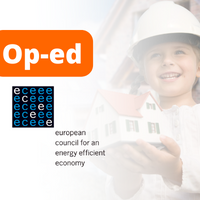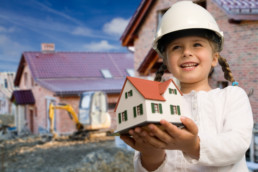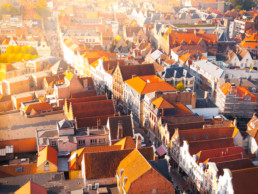Op-ed: Capturing the untapped benefits of deep energy renovation (Euractiv)
Published by Euractiv on: 4 March 2020 | As the European Green Deal takes shape, it bears repeating that the state of EU buildings holds the potential to make or break whatever energy, emissions and environmental targets are set in the coming months, writes Adrian Joyce.
Briefing 3/2020: Financing Deep Energy Renovation: The Roles Of Policy Action, Public-Private Partnerships And Financial Tools For Private Dwellings
As part of the final month of the #GreenDeal4Buildings campaign, Renovate Europe has produced two complementary briefings looking at the issue of financing deep energy renovation. While this briefing focuses on the need for strong policy, the potential of public-private partnerships, and the particular challenges of financing renovation in the residential sector, a complementary briefing examines ways to leverage funds through the Just Transition Mechanism and carbon revenues.
Within the EU context and existing 2030 energy savings targets, Renovate Europe notes an annual investment gap of €130-200bn. Some 80% of the investment is needed on the demand side, of which 71% must be directed to the residential sector, which is noted as being particularly challenging because the need for both action and financing is extremely granular.
Over the longer term – i.e. to 2050 – boosting the energy renovation rate to 3% annually would achieve the ambitious goal of reducing energy demand in buildings by 80% while drastically cutting carbon dioxide (CO2) emissions. In turn, this would cut total EU energy demand by 30%, reduce energy bills for all consumers, enhance productivity and increase property value and rentals. Such benefits could boost GDP by 0.7% annually; in 2020 alone, that would equal €39bn in additional public finances.
Renovate Europe calls upon EU institutions to ensure that the European Green Deal creates the ecosystem for deep energy renovation, including establishing stability that will eliminate the current ‘stop-go’ dynamic that erodes investor confidence. This includes making energy efficiency a top priority and planning beyond short-term measures.
You can read the briefing in full here.
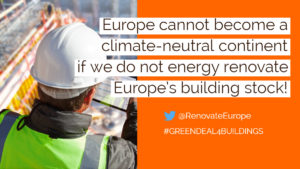
Briefing 2/2020: Financing Deep Energy Renovation: Leveraging The Just Transition Mechanism And Carbon Revenues
As part of the final month of the #GreenDeal4Buildings campaign, Renovate Europe has produced two complementary briefings looking at the issue of financing deep energy renovation. This briefing focuses on leveraging funds through the Just Transition Mechanism and carbon revenues, and a complementary briefing examines the need for strong policy, the potential of public-private partnerships, and the particular challenges of financing renovation in the residential sector.
Calculating the actual cost of renovating 97% of the existing building stock in the EU is no easy task. Various methodologies have been applied, each being met with both applause and critiques. Generally, a realistic number seems to be in excess of €300bn per year for the next 30 years. To drive that number home, it’s helpful to think of this way: ~€1 bn per day, every day until 2050.
While that is a lot, it is worth noting that the International Energy Agency estimates that aggressively implementing energy efficiency on a global scale could – by slashing energy bills, reducing energy imports and alleviating energy poverty – deliver benefits of €500bn per year.
Within the EU context and existing 2030 energy savings targets, Renovate Europe notes an annual investment gap of €130-200bn. Some 80% of the investment is needed on the demand side, of which 71% must be directed to the residential sector. Over the longer-term – i.e. to 2050 – boosting the energy renovation rate to 3% annually would achieve the ambitious goal of reducing energy demand in buildings by 80% while drastically cutting carbon dioxide (CO2) emissions. In turn, this would cut total EU energy demand by 30%, reduce energy bills for all consumers, enhance productivity and increase property value and rentals. Such benefits could boost GDP by 0.7% annually; in 2020 alone, that would equal €39bn in additional public finances.
Renovate Europe calls upon EU institutions to ensure that the European Green Deal creates the ecosystem for deep energy renovation, including establishing stability that will eliminate the current ‘stop-go’ dynamic that erodes investor confidence. This includes making energy efficiency a top priority and planning beyond short-term measures.
You can read the full briefing here.
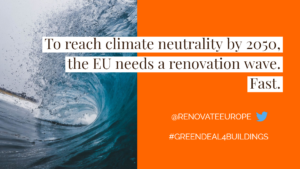
Op-ed: How building renovations support EU’s “Man on the Moon moment” (ECEEE)
Published by ECEEE on: 14 January 2020 | Launched as “the EU’s Man on the Moon moment”, the European Green Deal is massively ambitious in scope and scale. While we appreciate the breadth of its eight “deeply transformative policies”, Renovate Europe finds that the underpinning roles of energy efficiency and building renovations are not fully considered.
Briefing 1/2020: Proof of how buildings renovation can help meet the European Green Deal
During its first 100 days in office, the Renovate Europe Campaign will be tracking the development of the #EUGreenDeal – and proving why it must include a strategy for deep energy renovation of the building stock in the EU. We’re launching a social media campaign to call for an ambitious #GreenDeal4Buildings. The new European Commission have now been in office for over a month, and so are one-third of the way into their first 100 days as a Commission, at the end of which a number of pieces of legislation should be proposed. On December 11, 2019, a communication on the European Green Deal was published.
Launched as “the EU’s Man on the Moon moment”, the European Green Deal is massively ambitious in scope and scale. While we appreciate the breadth of its eight “deeply transformative policies” and are pleased to see these backed up with a Roadmap of 50 related measures, Renovate Europe finds that the vital and underpinning roles of energy efficiency and building renovations are not fully considered. This, the second article published as part of the Renovate Europe 100 Day Campaign, offers a sampling of projects already undertaken to show that it is technically possible and financially feasible to dramatically reduce the energy demand of EU buildings – by up to 80% on average. This article is not only proof of what is possible today but demonstrates the value of building renovation as a means to help achieve the goals of the European Green Deal.
The article can be read in full here.
Keep up to date with the #GreenDeal4Buildings campaign via the Renovate Europe Twitter & LinkedIn.

Briefing 2/2019: Capturing the untapped benefits of energy renovation
December 2019
During its first 100 days in office the Renovate Europe Campaign will be tracking development of the #EUGreenDeal - and proving why it must include a strategy for deep energy renovation of the building stock in the EU. We're launching a social media campaign to call for an ambitious #GreenDeal4Buildings. This article is the first of three that will be published as part of our #GreenDeal4Buildings campaign, and focuses on the many untapped benefits of energy renovation - such as emissions reduction, ending energy poverty, economic and wellbeing benefits.
As new Members of the European Parliament take their places and the European Green Deal — as promised by new European Commission President Ursula von der Leyen — takes shape, it bears repeating that the state of EU buildings holds the potential to make or break whatever energy, emissions and environmental targets are set in the coming months.
A growing body of research attaches figures to the value of benefits that energy efficiency measures deliver to public agencies, private entities, economies as a whole, and to individual citizens. Renovating private homes has a benefit-cost ratio of 4:1, reflecting reductions in healthcare expenditure, elimination of energy subsidy pay-outs, job creation and greater economic empowerment of citizens who are lifted out of energy poverty.
At present, buildings account for 40% of EU energy demand and 36% of carbon dioxide emissions. Each year, the EU imports 55% of its energy needs at a cost of approximately €300 billion. Most troubling is the reality that in 2050, nine out of ten existing buildings will still be in use.
Renovate Europe is pleased to see that buildings are included in early discussion of the European Green Deal. Yet to date, policy action in this area has failed to stimulate the level of deep energy renovation needed. During Executive Vice-President Timmermans’ first 100 days in office we plan to loudly advocate for renovation of the building stock as a tool not only to reduce emissions, but to capture a range of untapped benefits in terms of health, productivity and the economy.
The full article can be read here.
Keep up to date with the #GreenDeal4Buildings campaign via the Renovate Europe Twitter & LinkedIn.





